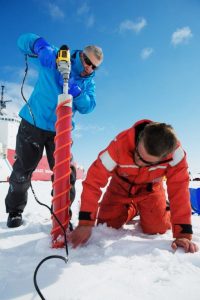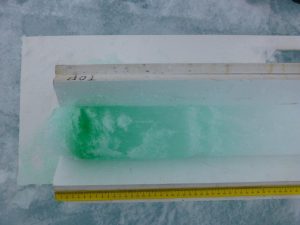24 January 2017
Arctic melt ponds form when meltwater clogs ice pores
Posted by Lauren Lipuma

Researchers drill a sea ice core to measure fluid permeability of the porous ice. A new study describes for the first time how meltwater ponds form on top of sea ice.
Credit: Amanda Kowalski/Woods Hole Oceanographic Institution.
Pond formation mechanism previously unknown
By Paul Gabrielsen
When spring comes to the Arctic, the breakup of the cold winter ice sheets starts at the surface with the formation of melt ponds. These pools of melted snow and ice darken the surface of the ice, increasing the amount of solar energy the ice sheet absorbs and accelerating melt.
Now, researchers describe in a new study how these melt ponds form, solving a paradoxical mystery of how a pool of water actually sits atop highly porous ice. The new study has been accepted for publication in the Journal of Geophysical Research: Oceans, a journal of the American Geophysical Union.
“Here we’re presented with this fundamental puzzle,” said Kenneth Golden, a mathematician at the University of Utah and co-author of the new study. “How in the world do you form ponds? When they form, how deep they are, and their areal extent is absolutely critical for how the ice is going to melt.”
Golden studies the dynamics of sea ice, a composite system of solids and liquids of varying salinity and chemistry. Melt ponds are a focus of his research because they dramatically affect the albedo, or reflectiveness, of the sea ice, one of the most important parameters in climate modeling. They also may allow more light to penetrate through the ice, allowing algae to proliferate in the seawater beneath.
In 2014, Golden and colleagues traveled aboard the U.S. Coast Guard cutter Healy to the Chukchi Sea, between Alaska and Siberia, to investigate massive algae blooms below the ice that had been first observed in 2011. As part of their study, they needed to measure the permeability of the ice, a measure of how well interconnected voids and channels within a material allow fluid to flow through.

Ken Golden measures the depth of dye seepage into the sea ice underneath a melt pond,
as Chris Polashenski looks on.
Credit: Amanda Kowalski/Woods Hole Oceanographic Institution.
Their first attempt involved drilling a hole in the ice down below the “freeboard level,” or water table, to see how quickly the water filled the hole back in.
“It filled up to the freeboard level in about a second and a half,” Golden said, indicating the ice was too permeable to make a measurement. Next, the team tried to add water to the hole to see how quickly the water level re-equilibrated to the freeboard level. They planned several attempts, and noticed that in the second attempt, the water level fell much more slowly than in the first attempt.
“And then the third time was the charm,” Golden said. The team poured water into the hole and the level didn’t go down at all. “We formed a melt pond!”
Intrigued, the team tested different levels of water salinity in boreholes and used food coloring to trace the progress of the water through the ice. All of their experimentation pointed to a clear mechanism for melt pond formation.

An ice core extracted from an area where green dye was spread over the snow and ice surface.
Credit: Ken Golden/University of Utah.
“The freezing point of the fresh meltwater from snow is zero Celsius [32 degrees Fahrenheit],” Golden said. “But the ice itself is maybe -1 or -1.5 [degrees Celsius]. The freezing point of seawater is -1.8 [degrees Celsius]. So basically, you’re getting this infusion of fresh water and there’s enough cold there to clog up the pores. You’re lowering the permeability of the ice by this process of freezing freshwater plugs into the porous microstructure.” With lowered permeability, the meltwater can form a pool on top of the ice.
Others had speculated that such a process might be behind melt pond formation, Golden said, but that his team was in the right place at the right time with the right equipment to put the story together in the field. Hopefully, he said, understanding the conditions that lead to melt pond formation can help scientists predict where and when ponds might form as Arctic temperatures continue to rise.
—Paul Gabrielsen is a science writer at the University of Utah. This post originally appeared as a press release on the University of Utah website.


 GeoSpace is a blog on Earth and space science, managed by AGU’s Public Information staff. The blog features posts by AGU writers and guest contributors on all sorts of relevant science topics, but with a focus on new research and geo and space sciences-related stories that are currently in the news.
GeoSpace is a blog on Earth and space science, managed by AGU’s Public Information staff. The blog features posts by AGU writers and guest contributors on all sorts of relevant science topics, but with a focus on new research and geo and space sciences-related stories that are currently in the news.